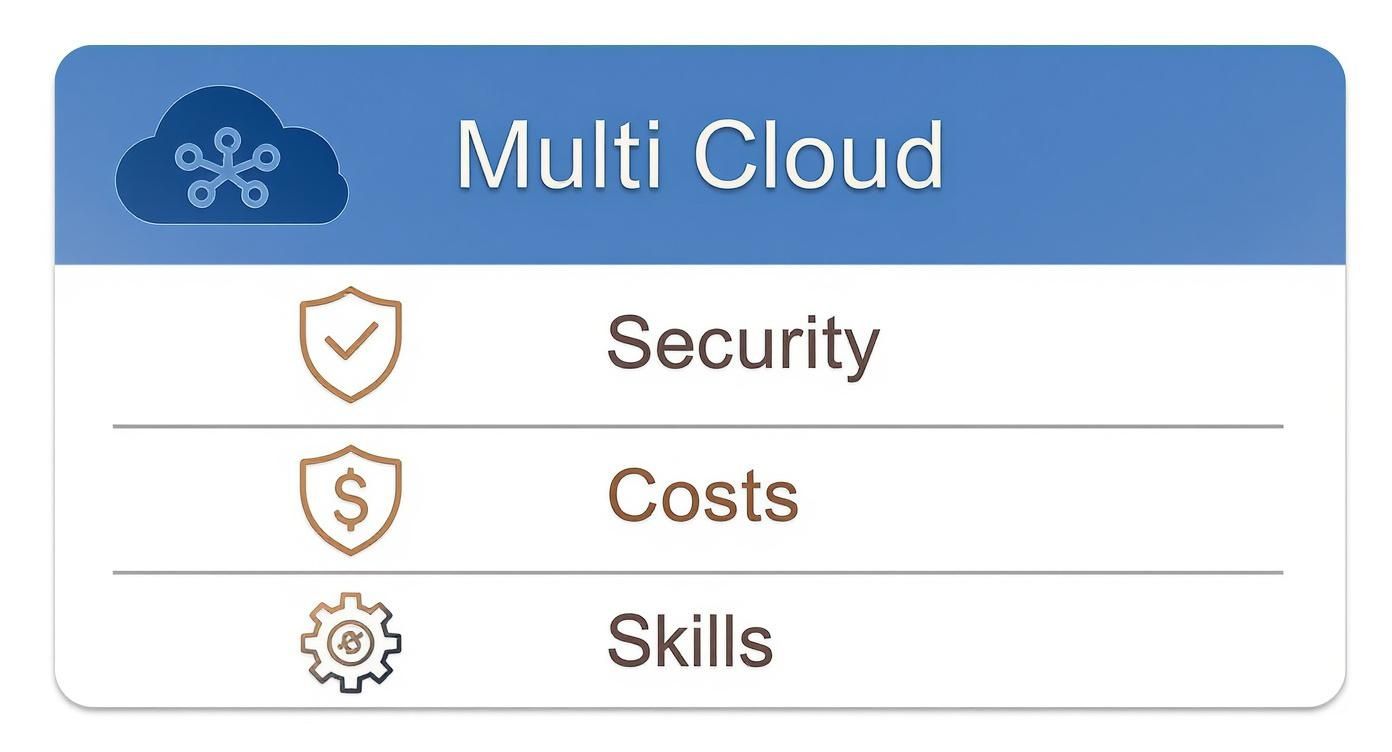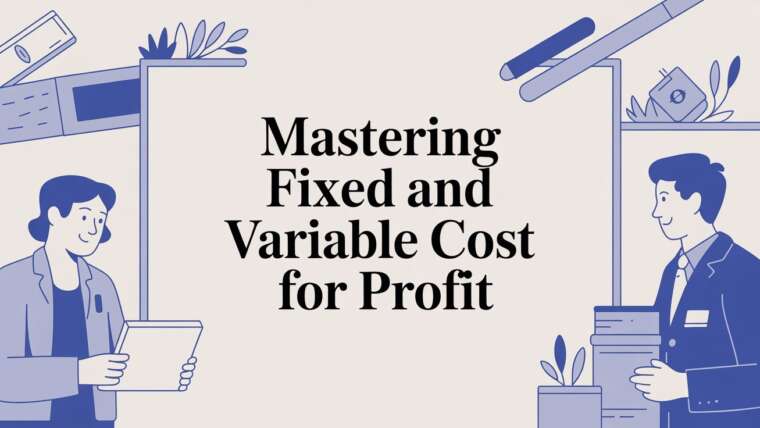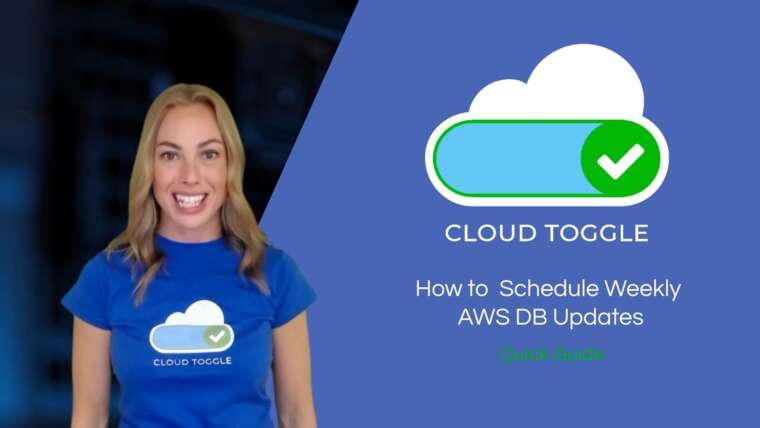Multi-cloud management is just what it sounds like: creating a single, unified system to monitor and control all your cloud services, no matter who the provider is.
Think of it like this: you wouldn't want three different remote controls to manage your AWS, Azure, and Google Cloud environments. You'd want one that does it all. That's the core idea here, and it’s a crucial one for businesses trying to get a real handle on performance and costs across different platforms.
What Is Multi-Cloud Management, Really?

Let's use an analogy. When you manage a diverse investment portfolio, you don't dump all your money into one company's stock. You spread your investments around to chase the best returns and hedge against risk. Multi-cloud management applies that exact same logic to your company's digital infrastructure.
It’s the strategy of using one central platform to oversee your applications, data, and workloads, even when they’re scattered across different public clouds. Instead of forcing your team to jump between separate dashboards for Amazon Web Services (AWS), Microsoft Azure, and Google Cloud Platform (GCP), they get a single pane of glass to manage everything. This consolidated view is the bedrock of any smart multi-cloud strategy.
The Core Purpose of Centralized Management
At its heart, multi-cloud management is about taming complexity. Every cloud provider has its own distinct tools, APIs, and security rules. Without a single management layer sitting on top, your teams are forced to become experts in multiple, separate ecosystems. That's a recipe for inefficiency and costly human error.
A solid management strategy creates an "abstraction layer" that smooths out the differences and standardizes how you operate. It gives you the power to:
- Deploy applications consistently: Use one workflow to push services to any cloud provider you choose.
- Enforce uniform security policies: Apply the same security and compliance rules everywhere, closing the dangerous gaps that can form between platforms.
- Monitor performance from one place: Keep an eye on the health of your entire infrastructure without flipping between a dozen different monitoring tools.
The real goal of multi-cloud management is to stop thinking of your clouds as separate, siloed environments. It's about transforming them into a single, cohesive, and efficient digital machine. You're not just adding more clouds; you're gaining control.
It's More Than Just a Tech Strategy
Good multi-cloud management isn't just about consolidating tools. It's a critical business move. It’s your best defense against vendor lock-in, which happens when your company becomes so tangled up with one provider that switching becomes painfully expensive and complicated.
With a multi-cloud approach, you keep your options open. You can move workloads to whichever platform is the most cost-effective or has the best tech for the job at any given time.
This strategy empowers you to pick and choose the best service for each specific task. You might use Google Cloud for its incredible data analytics tools while leaning on AWS for its massive selection of serverless computing options. To really get a grip on how this is done, it's worth learning more about what a cloud management platform is and how it helps pull all these moving parts together.
Ultimately, this approach turns your cloud infrastructure from a simple utility into a powerful strategic asset that fuels innovation and makes your entire organization more resilient.
Why Multi Cloud Is a Strategic Business Move
Thinking about multi-cloud as a simple IT upgrade is a mistake. It’s actually a powerful engine for business growth and a core pillar for achieving long-term scalability and security. Companies that strategically spread their infrastructure across multiple cloud providers gain a significant competitive edge, turning a technical choice into a fundamental business advantage.
This isn't just about having options; it's about building a more agile, resilient, and innovative organization from the ground up.
The growth in this space is staggering. The global multi-cloud management market was recently valued between USD 12.5 billion and USD 13.5 billion. But it's not staying there. Projections show this market expanding at a compound annual growth rate of nearly 28%, with its value expected to soar past USD 147 billion. This explosive growth shows just how seriously enterprises worldwide are embracing multi-cloud to get ahead.
Fuel Innovation with Best-in-Class Services
Let's be honest: no single cloud provider is the best at everything. Each major player like AWS, Azure, and Google Cloud has its own world-class specializations. Google Cloud, for example, is renowned for its data analytics and machine learning tools, while AWS offers an unparalleled depth of raw infrastructure services.
A multi-cloud approach lets you cherry-pick the absolute best services from each provider for the job at hand.
Imagine your development team building a new app. They could use Google's BigQuery for heavy-duty analytics, host the main application on Azure for its tight enterprise integrations, and tap into AWS Lambda for its powerful serverless functions. This freedom to choose the best tool lets your teams build better products faster, without being boxed in by a single ecosystem.
By refusing to be locked into one vendor's toolkit, you empower your organization to innovate at the speed of the market. It's about assembling a "dream team" of cloud services rather than settling for a single provider that's just "good enough."
Enhance Resilience and Avoid Downtime
Putting all your business operations on a single cloud provider is like putting all your eggs in one basket. If that provider has a major outage or a regional service disruption, your entire operation could grind to a halt.
The fallout from that kind of downtime can be catastrophic, leading to lost revenue, shattered customer trust, and a damaged brand reputation. It's a risk few businesses can afford to take.
A multi-cloud architecture gives you built-in redundancy. By distributing your applications and data across different providers in different geographic locations, you create a robust safety net. If one cloud goes down, you can failover to another and keep the lights on. This level of resilience isn't a luxury anymore; it's a critical requirement for any business that relies on its digital infrastructure.
Achieve Significant Financial Benefits
One of the most compelling reasons to adopt a multi-cloud strategy is the financial leverage it gives you. When you aren't tied to a single vendor, you can take full advantage of competitive pricing. Cloud providers are constantly adjusting their prices and offering new incentives, and a multi-cloud setup allows you to shift workloads to whichever option is the most cost-effective at any given time.
This strategy is also your strongest defense against vendor lock-in. As your infrastructure grows, a single provider can steadily hike up prices, knowing that the cost and complexity of migrating away are massive.
Multi-cloud keeps vendors honest and ensures you stay in control of your spending. Understanding the dynamics of the cloud providers market share gives you valuable context on how this competition plays out. Ultimately, this approach prevents long-term cost creep and gives you the financial flexibility you need for sustainable growth.
Navigating the Hidden Complexities of Multi-Cloud
While a multi-cloud strategy sounds great on paper, offering flexibility and power, it's definitely not a simple plug-and-play solution. Jumping into multiple cloud environments without a plan introduces a whole new layer of operational headaches that can quickly overwhelm even the most prepared teams.
Without solid multi-cloud management, the very benefits you're chasing, like cost savings and agility, can get eaten alive by these unforeseen difficulties. These aren't just minor technical quirks; they're genuine business risks. From security gaps to runaway spending, getting a handle on these hidden complexities is the first step to building a multi-cloud setup that actually works.
To put it another way, ignoring these challenges leads to fragmented operations, surprise vulnerabilities, and a chaotic infrastructure that’s nearly impossible to control.
The Struggle for Consistent Security
One of the first and most critical hurdles is keeping your security posture consistent everywhere. Every cloud provider plays by its own rules. They all have unique security models, tools, and best practices. How you manage access with AWS Identity and Access Management (IAM) is completely different from how you'd do it with Azure Active Directory, and their firewall settings don't translate.
This mismatch creates a huge risk. You can't just copy and paste security rules from one cloud to another, which inevitably leads to gaps and misconfigurations. Think about this: a recent report found that human error is a factor in over 90% of data breaches. That risk just multiplies when your team is juggling several different security systems. Without a single platform to enforce the same rules everywhere, you’re creating blind spots for threats to sneak through.
The Challenge of Gaining Clear Visibility
As your infrastructure spreads out, getting a single, clear picture of everything you own becomes incredibly difficult. It’s like trying to manage a global supply chain using separate, disconnected spreadsheets for each country. You just can't manage what you can't see.
This fragmentation makes it a nightmare to answer basic, but crucial, questions:
- What do we actually have? Do we know exactly what resources are running and where they are?
- How is everything performing? How can we possibly track application health when its parts are scattered across AWS and GCP?
- Are we being efficient? Are the resources we're paying for actually being used, or are they just sitting there costing us money?
Without this unified visibility, troubleshooting becomes a painful guessing game, and any strategic planning is based on hope rather than hard data.
The Universal Pain Point of Spiraling Costs
Maybe the most common frustration with multi-cloud is watching costs spiral out of control. Each provider has its own pricing model, billing cycle, and a dizzying array of services. Without a unified dashboard, tracking what you're spending is a chaotic mess of manual data entry, often ending with a shocking bill at the end of the month.
The lack of centralized cost visibility is a primary driver of cloud waste. Organizations without a unified financial operations (FinOps) approach often overspend by up to 30% on their cloud infrastructure due to idle resources, overprovisioning, and a lack of accountability.
This financial drain isn't just about paying for things you don't use. It's about losing the ability to forecast your budget with any accuracy, making it impossible to decide where to invest your resources for the best return.
Before we move on, let's look at how these challenges translate into real-world business problems.
The following table breaks down these common multi-cloud hurdles and connects them to the tangible impact they can have on your bottom line and overall operations.
Common Multi-Cloud Challenges and Their Business Impact
| Challenge | Description | Potential Business Impact |
|---|---|---|
| Security Gaps | Each cloud has its own security tools and protocols, making it hard to apply consistent policies across all environments. | Increased risk of data breaches, compliance violations, and reputational damage. Fines and legal fees can be substantial. |
| Lack of Visibility | Inability to get a single, unified view of all resources, performance metrics, and dependencies across different cloud platforms. | Slower troubleshooting and incident response times. Inaccurate capacity planning leads to poor performance or overspending. |
| Cost Overruns | Different pricing models and a lack of centralized tracking make it easy for spending to spiral out of control. | Wasted budget on idle or overprovisioned resources. Inaccurate financial forecasting and reduced profitability. |
| Operational Complexity | Teams need to master multiple platforms, tools, and APIs, leading to inefficiency and a steep learning curve. | Slower project delivery and innovation. Increased human error, team burnout, and higher operational overhead. |
As you can see, what starts as a technical problem quickly becomes a significant business obstacle. These aren't isolated issues; they feed into each other, creating a cycle of inefficiency and risk.
The Skills Gap and Operational Headaches
Finally, going multi-cloud means your tech teams need a much broader and deeper skill set. It's simply unrealistic to expect every engineer to be an expert in the unique APIs, command-line tools, and quirks of AWS, Azure, and Google Cloud.
This skills gap often leads to slower deployments, more mistakes, and burnt-out teams. Trying to stitch together different tools and automation scripts from each vendor only makes things worse. A script that works perfectly in one cloud might fail spectacularly in another, forcing your team to waste time building and maintaining fragile workarounds. This kind of operational drag directly undermines the very agility you were hoping to gain from multi-cloud in the first place.
Proven Best Practices for Managing Multi Cloud Environments
Successfully managing a multi-cloud environment is less about the tools you buy and more about the strategy you build. Without a deliberate plan, you're not really managing multiple clouds. You're just wrestling with a chaotic, expensive, and vulnerable collection of services. It’s the difference between a finely tuned engine and a pile of spare parts.
But with a structured approach, you can transform that fragmented setup into a cohesive and powerful machine. This means setting consistent rules, centralizing control where it counts, and giving your teams the right processes to succeed. These practices are your roadmap to taking back control and getting real value from your multi-cloud investment.
Think of it this way: any effective multi-cloud strategy has to solve for three core challenges: security, costs, and skills. Get these right, and you're on your way.

Mastering these three interconnected areas is the key to preventing friction and unlocking the true potential of using multiple clouds.
Establish a Centralized Governance Model
Your first move is to create a strong, centralized governance model. This is the official rulebook for your entire cloud ecosystem. It clearly defines who can do what, sets spending limits, and enforces the same security standards across AWS, Azure, GCP, or any other provider you use.
A solid governance framework is your best defense against chaos. It ensures every team, no matter which cloud they're on, plays by the same rules. This consistency is what stops configuration drift and compliance issues before they start, which are two of the most common headaches in scattered environments.
Unify Identity and Access Management
Different clouds mean different ways of handling user access. Trying to juggle separate identity systems for each provider is not just a pain; it’s a gaping security hole waiting to be exploited. A unified Identity and Access Management (IAM) solution isn't a "nice-to-have," it's critical.
This approach creates a single source of truth for all user permissions. You can consistently enforce important principles, like least-privilege access, making sure people only get the keys to the rooms they absolutely need. A unified IAM system cuts down on administrative work and dramatically strengthens your security by closing dangerous backdoors.
A centralized governance and IAM strategy is non-negotiable for effective multi-cloud management. It moves you from a reactive state of fixing problems to a proactive one of preventing them, creating a secure and predictable foundation for all operations.
Embrace Automation and Orchestration
In a multi-cloud world, manual tasks are the enemy of growth and efficiency. Things like provisioning servers, configuring networks, or deploying applications are not only slow but also magnets for human error. This is where automation and orchestration come in.
By using tools like Terraform for Infrastructure as Code (IaC), you can define your infrastructure in simple, repeatable scripts that work on any cloud. Orchestration platforms go even further, automating entire workflows from a developer's keyboard all the way to production.
- Reduce Human Error: Automation gets rid of the manual slip-ups that often cause security issues or downtime.
- Boost Efficiency: It frees up your engineers to focus on building great products instead of doing repetitive chores.
- Ensure Consistency: Every deployment is identical, every single time, no matter which cloud it's on.
This commitment to automation pays dividends in both operational stability and financial discipline. If you want to go deeper on the financial side, check out our guide on what is FinOps and see how it fits into a smart management strategy.
Create a Cloud Center of Excellence
Finally, long-term success with multi-cloud depends on growing your own in-house expertise. A Cloud Center of Excellence (CCoE) is a dedicated team that acts as your organization's internal cloud consultancy. They develop best practices, standardize tools, and guide everyone else.
Think of the CCoE as the central hub for all things cloud. This team is responsible for evaluating new tech, setting architectural standards, and training other teams to use cloud resources securely and cost-effectively. By building a culture of shared knowledge, a CCoE makes sure your organization can adapt and thrive as your multi-cloud world keeps changing.
Actionable Strategies for Multi-Cloud Cost Optimization

Wrangling costs is one of the biggest headaches in a multi-cloud world, but it's also one of your greatest opportunities. The secret is to stop thinking in theory and start putting concrete tactics into practice, ones that trim your cloud bill without kneecapping performance. This really requires a shift in mindset, treating your cloud spend less like a fixed utility bill and more like a dynamic expense you can actively manage and shrink.
When you take this disciplined approach, you bring real financial accountability to your cloud usage. Instead of getting a nasty surprise at the end of the month, you’re proactively shaping your spending habits. These are the practical, high-impact strategies that directly boost your bottom line and turn multi-cloud management from a cost center into a source of real efficiency.
Adopt a FinOps Methodology
First things first: embrace FinOps. Think of it as a framework that brings financial discipline to the chaotic, variable spending model of the cloud. FinOps isn't a tool you buy or a team you hire; it’s a cultural shift that gets finance, engineering, and business teams talking and collaborating. The whole point is to help everyone make smarter, data-driven spending decisions.
By weaving FinOps principles into your organization, you create a shared language and sense of responsibility for cloud costs. Engineers begin to see the financial impact of their code, and finance gets a much clearer picture of how cloud investments are actually driving business value. Getting everyone on the same page is the bedrock of any lasting cost optimization plan.
Gain Unified Cost Visibility
You can't control what you can't see. The biggest hurdle in multi-cloud management is often the mess of billing data coming from different providers. Each has its own pricing quirks, service names, and report formats, which makes getting a single, consolidated view of your spending a nearly impossible manual task.
This is where cost visibility tools become non-negotiable. A solid multi-cloud management platform will give you a single pane of glass, a real-time view of your expenses across every provider.
A unified dashboard that normalizes data from AWS, Azure, and GCP is the foundation of any effective cost optimization strategy. It eliminates blind spots and allows you to track spending trends, allocate costs to specific teams or projects, and identify anomalies before they become major problems.
With this centralized view, you can finally get straight answers to critical questions like, "Which team is burning the most cash?" or "Is our spending on Project X trending up or down?" This kind of visibility empowers every team to take ownership of what they use.
Implement Aggressive Resource Right-Sizing
One of the most common ways money gets wasted in the cloud is through overprovisioning, paying for more server capacity than you actually need. Resource right-sizing is simply the process of analyzing performance data and tweaking your instances to better match their real-world workload demands. And it's not a one-and-done fix; it's a continuous process.
Start by hunting for idle or underused resources. Look for virtual machines that consistently cruise along at low CPU utilization or oversized databases that are barely being touched. Downsizing these resources can lead to immediate and significant savings without hurting your application’s performance.
Effective right-sizing involves a few key steps:
- Monitor Performance: Always be collecting and analyzing performance metrics like CPU usage, memory consumption, and network traffic for all your cloud resources.
- Identify Candidates: Pinpoint instances that are consistently underutilized over a meaningful period. A classic example is a machine running at less than 10% CPU for two straight weeks.
- Resize or Terminate: Downsize the instance to a smaller, cheaper type, or just terminate it completely if it's no longer needed.
Use Intelligent Automation for Idle Resources
Beyond right-sizing, intelligent automation is another powerful tool for slashing costs. A shocking amount of cloud spend is burned on non-production resources, like development and testing environments, that are left running 24/7. In reality, these assets are often only needed during standard business hours.
This is where automated scheduling tools like CLOUD TOGGLE become a game-changer. Instead of nagging engineers to manually shut down their environments every evening, you can just set it and forget it with automated schedules.
For instance, a simple policy to automatically power down all dev servers at 7 PM on weekdays and keep them off all weekend can cut the fat from your idle resource costs. This tactic alone can shrink the compute bill for non-production workloads by more than 60%. The best tools offer easy overrides and role-based access, making it simple for teams to adopt these practices without messing up their workflows. That’s how you make savings that are both significant and sustainable.
What About Hybrid Cloud's Role in All This?
For a lot of companies, a smart multi-cloud strategy doesn't actually start with going all-in on public clouds. It often grows from a solid hybrid cloud foundation. Getting this relationship right, knowing what to keep private and what to push to the public cloud, is the real secret to effective multi-cloud management.
Think of a hybrid cloud as the best of both worlds. It’s a mix of your own private, on-premise servers and public cloud services from providers like AWS or Azure. This setup strikes that perfect balance between tight security and massive scalability, letting you operate with a ton of flexibility.
And this isn't just a temporary step; it's a deliberate, strategic choice. The data backs this up, showing that hybrid cloud setups recently made up over 56% of the multi-cloud management market. It's growing way faster than purely public or private models, with experts predicting a compound annual growth rate somewhere between 27% and 39%. This isn't a niche player; it's a dominant force. You can dive deeper into these numbers with these detailed market insights from Fortune Business Insights.
Keeping Your Sensitive Data On-Premises
So, why go hybrid in the first place? Control. It almost always comes down to control.
Some data is just too sensitive to park on a shared public server. Think financial records, private customer information, or your company's secret sauce (intellectual property). On top of that, regulations like HIPAA or GDPR have strict rules about where data can live and how it's secured. It's just plain easier to meet those demands in your own private environment.
By keeping this core data locked down on-premises, you have direct oversight. You can build custom security protocols that public clouds just can't match. This creates a secure "home base" from which you can confidently reach out and use the power of the public cloud.
Using the Public Cloud for Heavy Lifting
While your private cloud acts as the secure vault, the public cloud offers nearly infinite power for the really demanding jobs. A hybrid strategy lets you tap into that power without ever moving your most critical data off-site.
What does that look like in practice? Here are a few common ways companies use the public cloud half of their hybrid setup:
- Data Analytics: Need to crunch massive datasets? Firing up powerful, on-demand computing resources in the public cloud is way cheaper than buying and maintaining that kind of hardware yourself.
- App Development and Testing: Dev teams can spin up and tear down environments in minutes without waiting for new hardware to be provisioned. It’s fast, flexible, and cost-effective.
- Disaster Recovery: Using the public cloud as a backup and failover site is a game-changer. You get business continuity without having to build and maintain a complete duplicate of your physical data center.
The whole point of a hybrid strategy is using the right tool for the right job. It’s about keeping your crown jewels locked safely in your own vault while using the world’s most powerful tools to analyze, build, and innovate.
At the end of the day, it's the seamless integration and automation that make these two very different environments feel like one cohesive system. This connection is what gives businesses the agility to scale up or down, optimize costs, and react quickly to market changes, cementing the hybrid model's role as a cornerstone of modern multi-cloud management.
Answering Your Top Multi-Cloud Questions
When you're wading into a multi-cloud strategy, a few key questions always bubble to the surface. It's totally normal. Getting straight answers is the best way to build a solid foundation for your management approach, so let's tackle the most common ones we hear from organizations just like yours.
Getting these concepts right from the start is a game-changer. Without that clarity, it's all too easy to misinterpret the fundamentals, which can lead to flawed strategies and some pretty expensive mistakes down the road.
Key Concepts Clarified
One of the first hurdles is just getting the language right. What's the real difference between a multi-cloud setup and a hybrid one? Aren't they the same thing?
What is the main difference between multi-cloud and hybrid cloud?
It's a subtle but important distinction. Multi-cloud means you're using services from more than one public cloud provider, think using a mix of AWS and Azure. Hybrid cloud, on the other hand, involves mixing a private cloud (or your own on-premise data center) with at least one public cloud. Many multi-cloud strategies are also hybrid, but you can absolutely have a multi-cloud setup using only public providers.
Another big question that always comes up is about the bottom line. Does adding more clouds just automatically inflate the bill?
Is multi-cloud more expensive than a single-cloud strategy?
Not necessarily, and that's the surprising part. While juggling multiple platforms can add some complexity, it also opens up huge opportunities for savings. You can cherry-pick the most cost-effective service for each specific job and, crucially, avoid vendor lock-in, which almost always leads to higher long-term costs. The key is having solid multi-cloud management and FinOps practices in place to actually realize those savings.
Finally, everyone wants to know what they should brace for. What's the biggest headache they're likely to face on this journey?
What is the biggest challenge of multi-cloud management?
It really boils down to three things: security, cost control, and operational complexity. Trying to maintain consistent security policies across completely different environments is tough. And without a single, unified view of your spending, costs can spiral out of control before you even notice. Getting ahead of these challenges requires a centralized governance strategy and the right set of management tools from day one.
Ready to take control of your multi-cloud costs? CLOUD TOGGLE helps you stop wasting money on idle resources with automated scheduling. See how much you can save by visiting https://cloudtoggle.com and starting your free trial.




